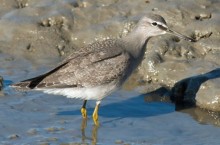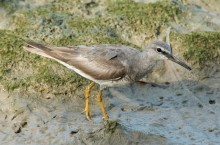Heteroscelus brevipes
Other Names
Siberian Tattler, Polynesian Tattler, Asiatic or Asian Tattler, Grey-rumped Sandpiper, Eastern Grey Sandpiper, Short-legged Sandpiper.
Identification
A medium-sized, grey wader with yellow legs and a straight bill
Plumage
Non-breeding: Upperparts comprising crown, nape, neck, mantle, scapulars and wings are a uniform grey. The supercilium is white and extends beyond the eye. Throat and chin are white. The breast is light grey and the rest of the lower parts are white. The bill is longish and black but paler yellow toward the base. Legs are dull yellow.
Breeding: Similar to non-breeding plumage but underparts are finely barred with grey. Legs are bright yellow.
Juvenile: Like adult non-breeding plumage but with buffy margins to the wing feathers.
Distribution
In Australia the Grey-tailed Tattler is found all along the coast and offshore islands, more abundantly in northern parts. It inhabits intertidal mudflats and mangrove areas. The species prefers to roost in mangrove trees but also frequents rocky areas, natural or man-made.
Migratory habits
The Grey-tailed Tattler usually leaves Australia in April and returns in September to northern parts gradually moving down the coastline until November.
Breeding
It breeds in alpine tundra in several regions of central and eastern Siberia from south of the Taimyr Peninsula eastward to the Anadyr Plateau. Breeding possibly also occurs in mountains on the Kamchatka Peninsula and Kurile islands.
Status
Australian population of this species comprises about 36,000 birds.
East Asian-Australasian Flyway Population: about 400,000.
Images
|
Grey-tailed Tattler – Fresh Juvenile:- Note the fresh buff scalloping on the tertials and covert feathers that show this is a newly arrived juvenile with fresh feathers. These buff edges wear quickly and traces can then often only be seen by careful examination in the hand, |
|
|
Grey-tailed Tattler – Non breeding adult:- Note that all the covert feathers are uniform grey, often with pale white fringes when the feathers are fresh, there are no buff scallops visible at all giving the bird a plain grey appearance. |
|
|
Grey-Tailed tattler – Breeding Plumage:- The adults develop heavy barring on the chest when they moult into their breedign plumage. |
Confusing Species
Wandering Tattler: Generally darker in breeding and non-breeding plumages. The eye-stripe does not extend as far back as on the Grey-tailed Tattler.
Terek Sandpiper: Often found roosting with Grey-tailed Tattler. Smaller, with darker colouration and more orange legs. Up-turned bill is the most obvious difference.





